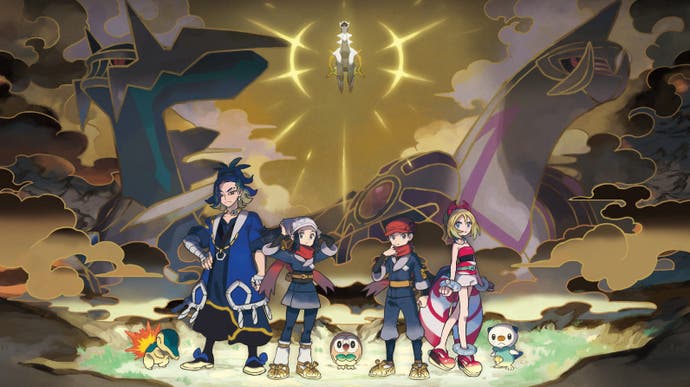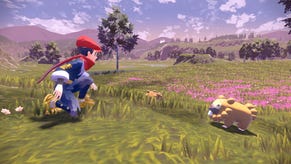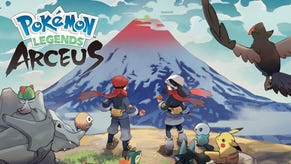Pokémon Legends: Arceus review - budget bare-minimum, or the series' purest form?
Pocket Monster Hunter.
It's a strange kind of punishment, being a long-term player of Game Freak's collective Pokémon works. To have played all these games as they came out is to be forever tormented by the series high of Pokémon's early gems. For many these are all-time video game highs: deep, vast, iconic giants, games that launched and subsequently bottled the lightning of a generational craze. Continuing on beyond them means suffering a kind of constant haunting by the hypothetical, the what-if world where the studio is given the time and budget and technical talent it so obviously needs - and that the Pokémon Company, owner of the highest-grossing media franchise of all time, can so obviously afford.
But it's also to be dragged along still by the series' superlative, enchanting, uber-compelling core: battle, trade, collect. Yes, there's a lingering sense of austerity and belt-tightening, of a kind of savage, self-inflicted economisation and distillation of Pokémon games into the absolute barest necessities for existence. Of a publisher with a fondness for ever-tougher rounds of development-budget limbo. But this is just what it means to enjoy Pokémon, now. You want more, you feel you really should want more, but by some twist of dark magic you're left feeling grateful for what you've got.
It's never been as evident as it is in Pokémon Legends: Arceus. Part-remake, part-prequel, Legends: Arceus traces a sketch across the events of Pokémon Diamond and Pearl, the fourth generation of main series games that only last November had a closer, similarly penny-pinched remake of their own in Brilliant Diamond and Shining Pearl. Legends: Arceus is set a long, long time before them in a kind of feudal-Japan version of the Sinnoh region, here called Hisui and scattered with great, unspoiled basins of land where gen four's cities would be, plus a single settlement of Jubilife Village and a few, weirdly Olympian ruins here and there.
Legends: Arceus' story is heavily and somewhat absurdly embargoed, considering the titanic flood of leaks ahead of launch, but the crux of it is this: you're part of the Galaxy Team, recent settlers here in a land where humans are mostly terrified of Pokémon, where the Diamond and Pearl Clans bicker over different versions of their god, and where some ominous rift in the sky has blasted a handful of Noble Pokémon with a peculiar bolt of lightning, whipping them up into a frenzy. You have two jobs: quel the Nobles' frenzies, and help your pals in Galaxy's Survey Corps by catching Pokémon. Lots of Pokémon.
This is where one of Legends: Arceus' many big departures from regular Pokémon games comes in, and arguably its biggest. In this period, your Pokédex is a book. A physical catalogue of Pokémon caught and registered by hand. Rather than catching a Pokémon once and it being fully registered in the 'dex, you'll need to fill out several smaller objectives to complete that species' page. The worry is that this might prove repetitive - and it can be, occasionally - but thankfully it's a little different in practice to how it sounds on paper.
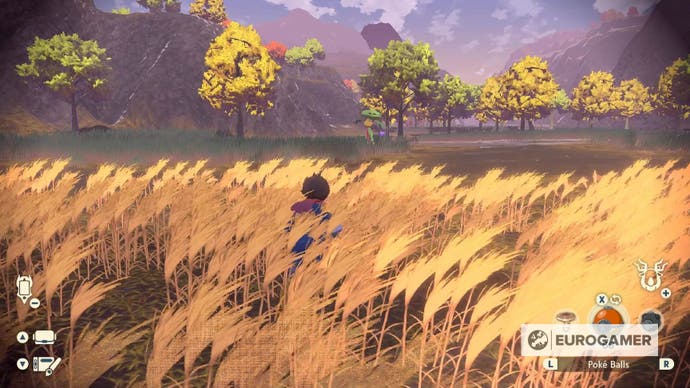
There are plenty of different research tasks you can complete for each Pokémon, for starters. Catching more and more of them is one, yes, but so is catching them with a "back strike" (donking them on the back with a Poké Ball without being spotted), so is defeating them in battle, seeing them use certain moves (on you and your squad or as commanded by you yourself), and so is evolving them or even completing a special one-off sidequest that involves that species in some way. The result, basically, is that you'll fill out plenty of pages without really realising it, just by working your way around Hisui as you normally would.
Doing all this gives you research points, and you can see the cycle forming. Research points are a kind of XP that goes towards your star rank in the Survey Corps. As you rank up - and also progress the main story, delivered via "missions" as opposed to the sidequests named "requests" - you'll then get access to new areas and new means of traversing the world (structurally, think of Hisui like a Monster Hunter game more than a fully open world). You'll get new Pokémon to ride, replacing the old HMs like Fly and Surf and of course going beyond those officially shown so far. That means access to more new Pokémon and more research tasks to fill out, more research points, and on it goes. It's a delightful loop, borne of a kind of recursive influence from the collectathon joys of Pokémon Go, a game that itself started out as a frightfully barebones, compulsion-first reflection of the main series.
A successful catch, for instance, grants you the pleasure of a wonderful little fizz-crackle of a firework - I am fully addicted to that sound - along with accompanying, saliva-producing jingle and the sight of a few numbers going up. It is compulsive, sure, but the process is intrinsically compelling too. The way wild Pokémon, more vibrantly animated here than in any previous game, are all hops, rolls, lumbers. All splashes, naps, growls, and waddles. The way they exist so unelaborately but with so much personality is such a simple treat, fit for anyone who cares about the pleasures of observing animal life, that finding more and more of them is reward enough on its own.

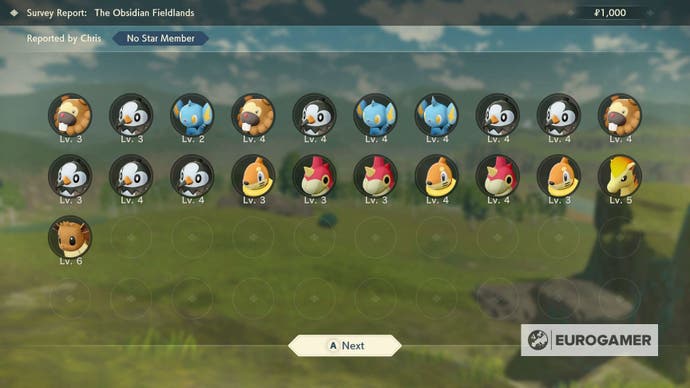
There's also a decent game of cat-and-mouse to actually catching them, too. Different species have different temperaments but generally, you'll need to avoid being seen. Your tactics shift to a kind of predatorial stealth, sneaking up for those back strikes, dodging attacks when spotted - more on that shortly - or catching Pokémon while they have a snooze. A little more thought's required as to how you approach a scenario before you go barrelling into battle. There's more incentive to use different kinds of Poké Ball here than in traditional games, as they have genuinely different trajectories and use cases. Held items are gone, but their place is taken by things that help you prowl the wild. Baits, smoke bombs, lures.
Alongside catching, then, comes crafting. Something that's played a supporting role in Pokémon since the days of Kurt and his Apricorns (which are back!) but steps up to prominent view here. The one thing you'll find besides Pokémon in the areas of Hisui are crafting materials. Trees hold berries and those Apricorns, which combine with materials granted by weird smashable crystals to make Poké Balls, while other assorted gubbins will be dotted around the land and dropped from various wild monsters defeated and caught. Together with catching you'll often slip into a kind of multitasking trance, toggling between throwing an empty ball to catch a rare Pokémon unawares, a full one, containing one of your Pokémon, to smash a crystal or headbutt a tree, an empty ball for another nearby Pokémon, then another of your Pokémon for a battle, on and on, swapping it up on the move like you're flicking from Battle Rifle to Energy Sword in Halo.
There's real, brilliant tension out here in the wild, occasionally replaced by something closer to hysterical panic when some giant, Alpha foe comes galloping up to you while you faff about with the controls trying to get the right thing out of your pocket. This is where battling comes in, the other huge departure from Pokémon convention. There are genuinely too many changes in systems to list, so better to start from what the new system is than what it isn't.
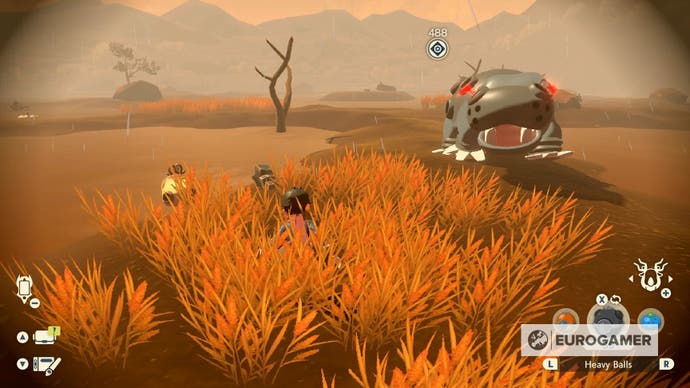
It's turn-based, but the move order is visible and can change depending on what you do, which makes it feel more like Final Fantasy at times (especially when one of the tracks, one of many authentic bangers in Legends: Arceus' all-timer of a Pokémon soundtrack, sounds like it's come straight from the twangy, chip-synth score of FF7, and when several enemy Pokémon, even in trainer battles, can line up against your sole Pokémon at once.)
Status effects like paralysis, burns, and the tweaked "drowsiness" and "frostbite" now tend to get shaken off, meanwhile. Stat-modifying moves like Swords Dance only last for a set number of turns. This has an outsized effect in Legends: Arceus, especially when combined with the new kinds of attacks. When a Pokémon's used a move (or simply levelled up) enough times it will "master" that move, allowing it to use it in Agile- or Strong-style. This means either increasing the frequency of your turns in the move order, for slightly less damage, or decreasing it for slightly more. Generally, with both sides cracking the tactic of "do an Agile-style first to get a small, extra hit in, then follow with a Strong-style for the KO", I found most battles with multiple rounds or against trainers with multiple Pokémon went something like: I knock out their Pokémon, their next one knocks out mine, my next knocks out theirs, repeat until they run out of Pokémon and I win.
It's less than satisfying, really, and not helped by a slight lack of clarity, some of which will fade away as the community inevitably explains the system's unexplained, but some won't. It's not clear, for instance, when an opposing Pokémon will get to attack you before you can even choose your own action. One known case is when an opponent initiates battle with you first, like when you're spotted by a wild Pokémon or challenged by a trainer, but other times it'll happen without warning. Thanks to those new systems, that can mean it attacks several times in succession, leaving you down not one but two or even three Pokémon before you've pressed a button.
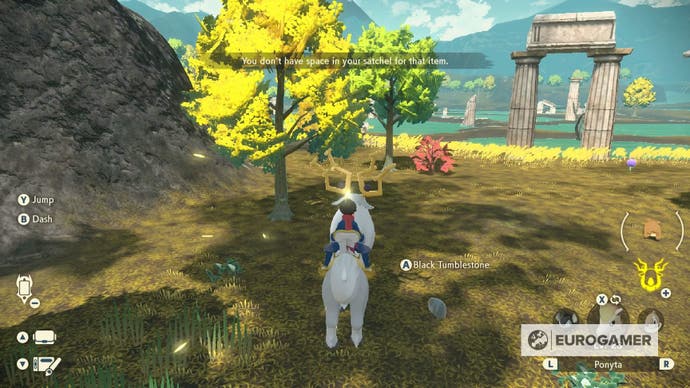
Once-called priority moves, meanwhile, like Quick Attack or Aqua Jet - which don't guarantee priority now but do give you much more chance of attacking first - seem to have an outsized strength as a result, too, and are pretty essential for most Pokémon's kits, unbalancing things a little. Similarly awkward: experience is only doled out at the end of an entire battle, to your whole party, as opposed to after each enemy is defeated, which means that often your leading Pokémon - who did the heavy lifting but likely got knocked out mid-way through - misses out on all the XP, unless you spend several minutes rotating through others and tanking hits to give it a Revive.
There are flipsides to of all this, however, the most obvious being challenge. Some vocal fans have been crying out for this for years now, and as main series Pokéon games have generally pitched themselves younger and younger, Legends: Arceus will be a welcome change. Battles, clearly, can be pretty tough. I was rarely if ever over-levelled and, towards the end of the story, often a good 10 levels below my opponents having done little to no proper grinding. That gives you the nice choice of spending more time adventuring, documenting and battling wild Pokémon to get more levels and items and powerful Pokémon themselves, or to charge along and up the rapid incline of the core story.
Standouts on the difficulty front are absolutely the Alpha Pokémon mentioned earlier. These are giant versions of standard Pokémon with higher base stats, and more Effort Points (which, for the more competitively inclined, replace EVs and are boosted this time with items call Grit Dust and the like, instead of which Pokémon you defeat in battle. Add these to the proliferation of Candies and Lures and again you see the Pokémon Go influence.)

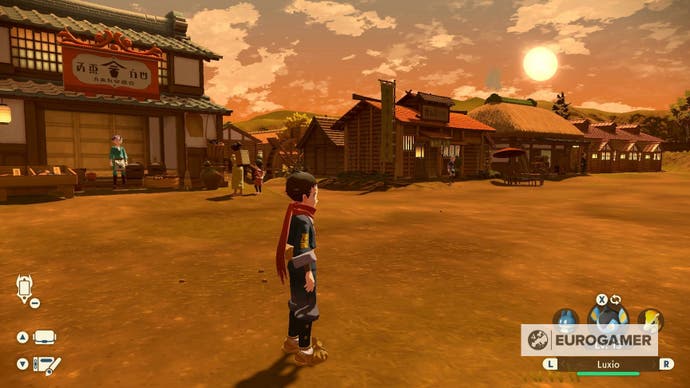
They also wield more powerful moves, and factoring in how near-impossible they are to sneak up on without the right items - meaning they'll usually spot and attack you first - this makes for a tasty challenge in battle. They spawn at well above the level for the area and usually well above your own. They kick out mega damage. They're mini-bosses, basically, and a whacking great provocation to the players who fancy trying their luck - especially if you want to catch them instead of simply winning.
Bosses! More new systems still. Nobles - that Kleavor you've likely seen far too many times by now being the first of them - are the final big change, replacing Gym battles in a way as the main, trackable mark of your progress. There are five, increasing quite significantly in difficulty as you go, and they centre on the final major change to Pokémon's formula. You, the trainer, can now be attacked and K.O.ed, which is where you'll "black out" instead of if you just run out of Pokémon that can fight.
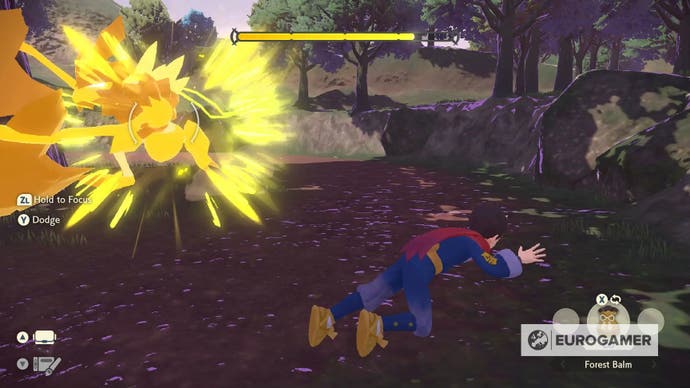
The boss fights themselves are so-so, tense enough but frightfully simple: dodge attacks, yeet balms at the big enemy until you have a short window to battle them with Pokémon, repeat. Enemy attacks get much more elaborate with much shorter windows of telegraphing but, ultimately, the battle is always the same, making the system feel like a bit of an afterthought. The obvious comparison is Monster Hunter, given the similarity in theory. But compare the two in practice, where in Monster Hunter all the foraging, observing and grinding is part of gearing up for the big fights. In Legends: Arceus the two are completely unrelated, the Noble battles feeling like they were dropped in from another game entirely.
Those nitpicks are compounded again by the technical state of Legends: Arceus, which by modern standards - or, depending on your mood, even rather un-modern standards - is really not great at all. There's regular pop-in, along with so-so frame rates and remarkably low-quality textures, and this is just the stuff in the foreground. Animations - aside from the endearing characterisations of the Pokémon themselves, which rightfully take priority - are minimal at best, edging dangerously close to that infamously under-animated Zacian/Zamazenta that blankly swivelled on the spot during the climax of Sword and Shield.
Is it overzealous budget cuts or pure, minimalist design? Is it empty, or is it filled with newfound nimbleness?
The temptation is to say that Game Freak has done well considering, putting together some lovely sunsets and something that leans towards - if never really gets close to - the impressionist strokes of The Legend of Zelda: Breath of the Wild. But, considering what? This is the question that won't go away with Pokémon, now - not until the presentation of these games gets anywhere near the expectations for a series that consistently sells in such remarkable numbers, and is supported by a brand of such all-conquering might.
Maybe the success is part of the problem, a cause for complacency or evidence that no more investment - be that time, talent, money, whatever - is needed. And yes, these days the video games bring in barely a fraction of that big, yellow paycheck each year. But they are also what started it all, which should count for something. With all the rapid, remarkable expansion into clothes and stationary and sleep apps and whatever else, there's a heavy sense of the tail wagging the dog. What does all this branded merchandise exist for, if not to service the video games and the trading cards, the things that Pokémon actually is?
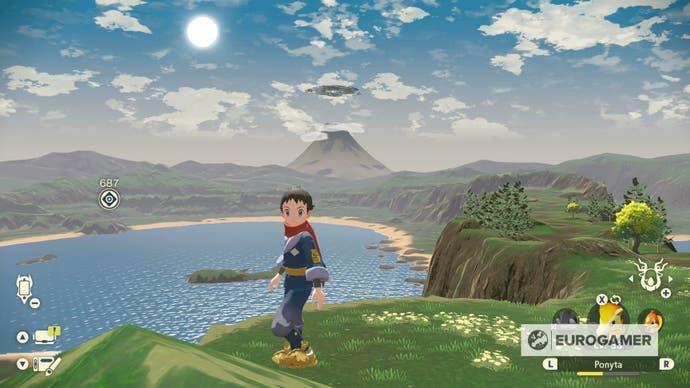
It's hard not to despair. But then, there is the other side of this again, the spell, the enchantment of the series' mystical core. For all the nods to Breath of the Wild - the Arc Phone-slash-Sheikah Slate, the Nobles-slash-Divine Beasts, the manual-waypoint map, the mournful, painterly style, the Link-like grunts, the foraging, the crafting, and most of all the way you just cannot get from A to B without being distracted by some curious twinkle on the periphery - it is not Breath of the Wild first. For all the reciprocal borrowing from Pokémon Go, for the structure of Monster Hunter and the vibes of Final Fantasy, it isn't those either.
There's an overpowering sense of novelty to Pokémon Legends: Arceus. This is something new, and it's also Pokémon, a decades-old series, in its purest essence. Battle, trade, collect. Even then there's a fraction of the trainer battles, nothing online, an option but no more necessity to trade. Is it overzealous budget cuts or pure, minimalist design? Is it empty, or is it filled with newfound nimbleness, of the kind that inspires all that wonder and awe precisely because so much of it has been chipped away?
Either way, this is a game crafted by subtractive sculpture. And how weirdly refreshing that is, compared to our artform's current, insatiable appetite for only adding more and more. Pokémon Legends: Arceus is either this series' bare minimum, or its purest form. I think it's both at once.
